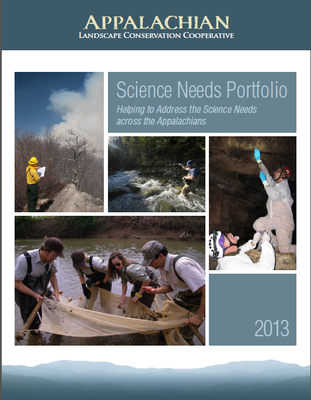Science Needs Portfolio
In February 2013, almost 50 experts from a wide range of technical background in both natural and social sciences, as well as geographic expertise across the entire region, volunteered to participate in the annual review of the Appalachian LCC Science Needs Portfolio. 2013 marked the first revision of the Portfolio.
The Science Needs Portfolio is the cornerstone of the Appalachian LCC Science Program. It is organized by thematic areas (Aquatics, Human Dimensions, Forests, Climate Change, etc.). It is structured to identify the highest-level of “MISSION: SCIENCE and MANAGEMENT OBJECTIVES,” sub-divided and described by “PROGRAM” and identifies initial thinking on the type of activities or “PROJECTS” that would, in total, combine to make up the Program elements. The initial drafting of the Portfolio followed one-year of consultations with partners and culminated in a working draft that served as the starting materials for further refinement and revision through a 3-day Conservation Priorities Science Needs Workshop held in November of 2011.
It is recognized there are different ways to describe and organize science needs. For the purpose of assembling a vast amount of information, a broad group of thematic areas were selected for the purpose of the Portfolio organizing structure. The Science Needs Portfolio is structured around these areas: [1] Aquatic, [2] Cave/Karst & Minelands; [3] Wetlands, [4] Forests, [5] Openlands/Grasslands; [6] Human Dominated/Economic Lands – renamed as “Working Lands” (e.g., urban, agricultural, and energy); [7] Human Dimensions ( issues of environmental benefits or ecosystem services that benefit human communities and associated social expectations); and [8] Climate Change.
Full Report
Thematic Areas
AQUATIC - Mission is to maintain native habitats and endemic aquatic species in their current locations or support these as they migrate with land use and climate changes in the future.
CAVE/KARST & MINELANDS - Mission to conserve and manage cave/karst and restored mine land (CKM) communities across jurisdictions.
WETLANDS - Science Objective is to inventory significant regional wetland habitats, evaluate the condition and importance of these habitats, and identify regional threats impacting those resources. Management Objective is so that LCC partners and stakeholders can develop and implement cohesive regional management strategies to protect and manage wetlands across jurisdictions.
FOREST LANDS - Mission is to identify and prioritize regional forest habitats and natural communities to foster resiliency in the face of current and future threats while supporting a larger multijurisdictional framework for planning and management.
OPEN LANDS - Mission is to maintain native habitats and native species in their current locations or support these as they migrate in response to land use and climate changes in the future.
WORKING LANDS - Mission is to improve planning and integration of “working lands” (which include urbanized, agricultural, forestry, industrial, and energy development) and conservation interests.
HUMAN DIMENSIONS - Mission is to incorporate ecosystem services values into natural resource decision-making.
CLIMATE CHANGE - Mission is to create an effective adaptation strategy for climate change based on the best available science.
2012 Science Needs Portfolio
2011 Conservation Science Needs Workshop Products
Conservation Priorities Science Needs Workshop
There are currently no results for this search.























